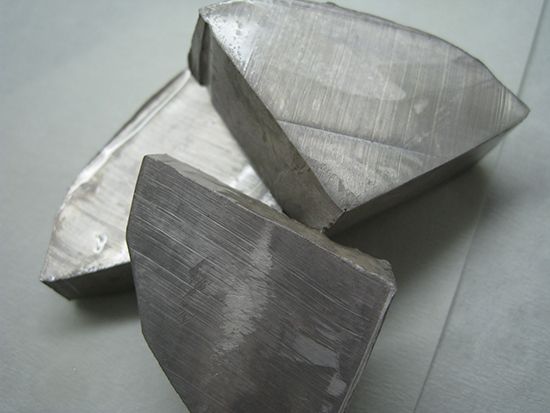 Sodium is a chemical element that belongs to the group known as alkali metals. It combines with other elements to form many useful substances. The most familiar compound, or combination, of sodium and another element is common salt. Scientists use symbols to stand for the chemical elements. The symbol for sodium is Na.
Sodium is a chemical element that belongs to the group known as alkali metals. It combines with other elements to form many useful substances. The most familiar compound, or combination, of sodium and another element is common salt. Scientists use symbols to stand for the chemical elements. The symbol for sodium is Na.
Sodium is a very common element, but it is never found on its own in nature. That is because it reacts very easily with other elements to form compounds. It will form a compound with almost anything that it is exposed to. The compound sodium chloride, or common salt, is the most important source of sodium. Most other sodium compounds are prepared either directly or indirectly from sodium chloride. The compound consists of sodium and chlorine. It occurs in seawater and as rock salt. Other compounds of sodium can be found throughout the world. Chile and Peru have large deposits of a compound called sodium nitrate.
Scientists can separate out sodium from its compounds to get the pure form of the element. In this form sodium is a very soft, silvery-white metal. It is a good conductor of electricity and of heat. Sodium is called an alkali metal because it forms an alkali, or a strong base, when it combines with certain other elements. Bases are a group of substances that behave in certain common ways.
Animals need sodium in order to keep the right level of water in their bodies. They get this sodium by eating salt. Another natural compound of sodium is sodium nitrate. Farmers use sodium nitrate as a fertilizer for their crops. In addition to salt and sodium nitrate, some of the most common compounds of sodium are baking soda, soda ash, and caustic soda. Soda ash is used in making glass, detergents, and cleansers. Caustic soda, or lye, is used in the making of soap, cellophane, paper, and other products and in refining petroleum. Scientists can create new compounds from sodium as well. These compounds are used in manufacturing to make chemicals and drugs. One of the few uses of pure sodium is in vapor lamps along streets and highways.




